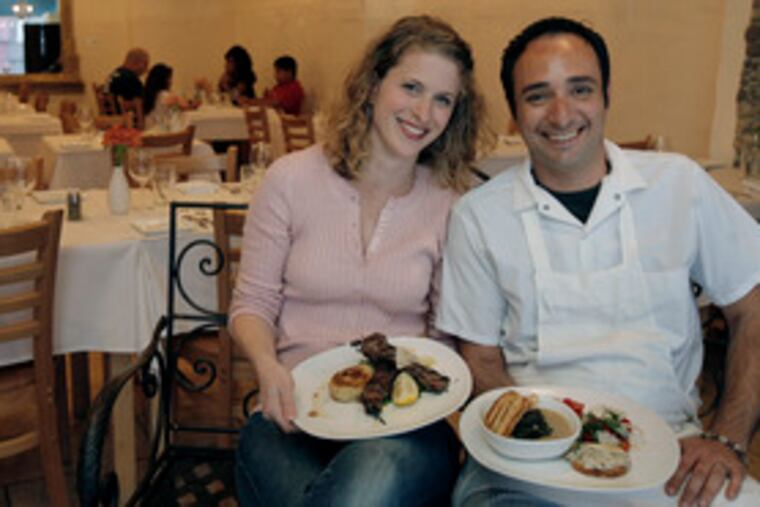
Life is a bottomless pasta bowl for fans of Philadelphia's Italian BYOBs. Hardly a week goes by without yet another new trattoria turning on the lights and firing up an espresso machine.
I expected the pace to slacken a couple of years ago. But it hasn't, even if some of the more mundane efforts prove unequivocally that there is such a thing as too much fried calamari and penne pomodoro.
There have been a few notable stars, though, cooking from the heart of the trend. And chef Davide and Kathryn Faenza have rightfully won a strong following for their unique interpretations of regional southern Italian home cooking at their tiny L'Angolo in South Philadelphia. Who can blame them for wanting to expand - after seven years - beyond L'Angolo's 35 seats?
That is exactly what they've done at Salento, the four-month-old 70-seater they've opened just northwest of Rittenhouse Square. Of course, Rittenhouse happens to be one of the most densely trattorized neighborhoods in town, with Melograno, Caffe Casta Diva, Branzino, Porcini, Roberto Cafe, and Gioia Mia among the best.
Salento is bigger than most of those, though I'm not especially charmed by the room. Part of L'Angolo's appeal remains its intimate quarters. Salento feels vaguely like a bustling basement space, though I now understand that its whitewashed plaster walls, linen-draped four-legged tables, and pale-blue fabric accents were intended to evoke the austere Greek influence common in Faenza's home region (Salento) at the bottom of Puglia on Italy's heel.
What Salento may lack in warm decor and pure comfort (the room is incredibly noisy, despite sound treatments), the restaurant more than compensates for in outgoing service and genuine flavors.
The menu's style is similar to L'Angolo's, though it mostly avoids duplication, and Faenza focuses on the aspects - bean dishes, seafood, and game ragus - that distinguish his region and hometown of Gallipoli.
The antipasto Pugliese is a good example, with various bruschetta (most notably a tangy carpaccio of cured swordfish) that ring an earthy bowl of pureed fava beans ribboned with dandelion greens.
Beans and grains are a major part of Faenza's palate, and they appear atop a brothy bowl of mussels brimming with the textures of soft cannelini, snappy chickpeas, and toothsome grains of farro wheat. Chickpeas, a legacy of Puglia's connection to the Middle East, are cooked to a creamy puree and tossed with homemade pappardelle in ciceri e tria, a hearty dish I loved even if the garnish of fried noodles wasn't as crisp as it should have been.
Those homemade pappardelle are also used to good effect beneath a special ragu of boar, a rustic style of country stew that is one of Faenza's better themes. A slowly braised goat stew adds earthy richness to the soft puff of potato- and mascarpone-filled ravioli. Tender shreds of duck, steeped in white wine and thyme, tumble over ear-shaped orecchiette, a favorite pasta in Puglia.
Faenza also makes an intriguing Gallipoli-style "pesto" from zucchini, cooked down with garlic and pureed, so it thickly coats linguine that tangles with sauteed shrimp. His ricotta gnocchi, crisped into little plugs and tossed with sauteed mushrooms, were also memorably light and airy.
The long-stemmed artichokes are cooked in a Roman style, pressed into flower shapes and pan-crisped with lemony, garlicky oil, and they are not to be missed.
The cold octopus-potato salad, on the other hand, was chewy and less exciting. Faenza's pan-fried entrees - the generous veal Milanese and unexpectedly bland olive-crusted swordfish (though a side of caponata helped) - were breaded less delicately than they could have been.
Two fish entrees, the monkfish wrapped in not-crisp-enough pancetta and a striped bass special over mushy shrimp ravioli, were uninspired for $22 and $24, respectively. The entrees here are large, but I'd prefer smaller portions for a couple of dollars less.
A simple balsamic-splashed salmon over grilled endive and firm Sicilian lentils was more rewarding. On the whole, though, Salento's meat entrees were the menu's best bet. My favorites were the grilled spiedini morsels of garlic-marinated lamb skewered on rosemary twigs, served with a crispy mashed potato cake enriched with mascarpone. Moist chicken breast was gift-wrapped in a snappy band of smoky speck ham. The juicy seared pork loin came topped with a thyme-scented wine gravy filled with crunchy bits of pancetta that worked the pig-on-pork theme to delectable art.
While Davide is the man behind the savory kitchen, Kathryn (a former waitress whom Faenza romanced with tomato roses) is a talented pastry chef. Her sweets are homey, but satisfyingly well-crafted.
Panna cotta is infused with lemon and candied ginger. Rice pudding made with arborio is cooked to just the right texture. A challah bread pudding ribboned with banana and chocolate is moist without being heavy. Fresh blueberries dusted with nutmeg come over a buttery tart crust. And dark chocolate semifreddo has a cold, creamy richness that melts with the subtle crunch of crushed hazelnuts.
With a finale like that, and homespun dishes that reflect the soul of Faenza's region, this pleasant new Italian makes a good case to keep the trattoria trend rolling.